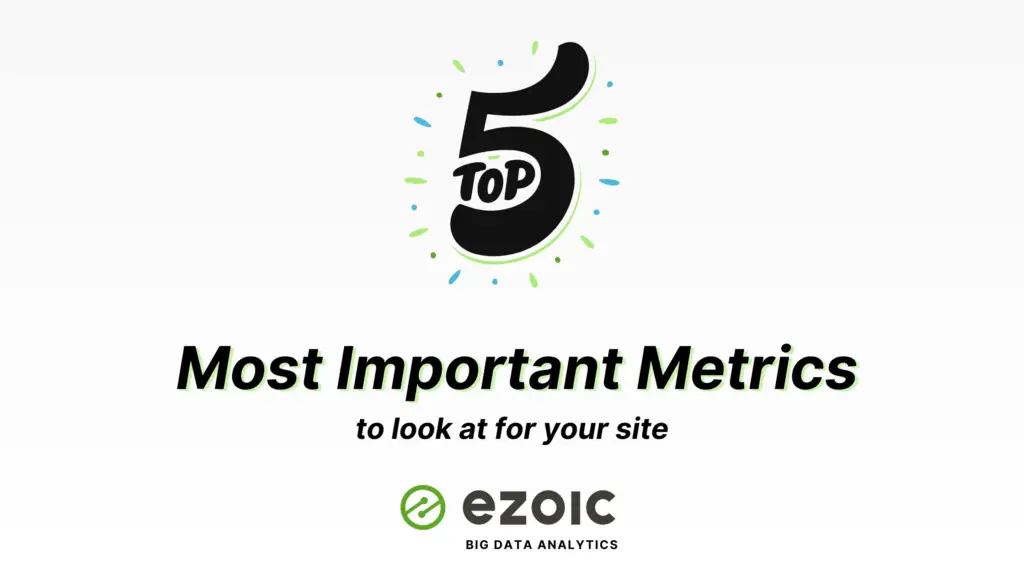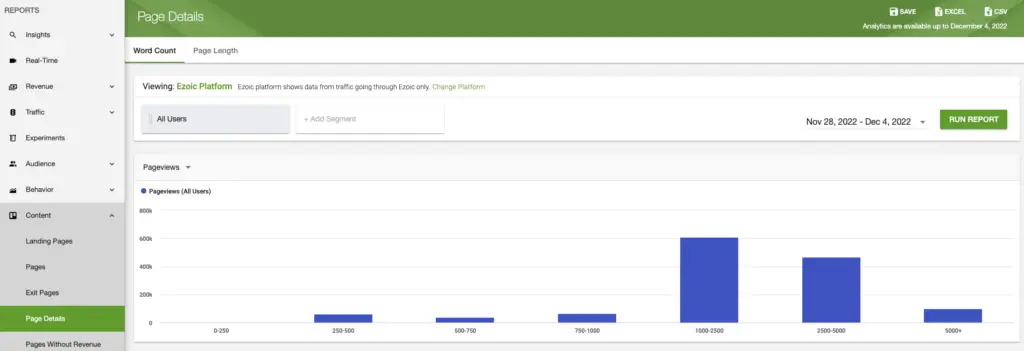
A Quick, Easy Way to Do a Site Review (so You Can Have a Better 2023)

Get helpful updates in your inbox
I created my first website in 2012. It was meager, plain, even boring; the content was written by a nervous amateur writer afraid of the slightest criticism. I never got more than 30 views in a single month, and looking back, it’s easy to see why.
In the ten years since, I’ve built far bigger websites. In the past few years alone, I was able to amass nearly ten million views, over 125,000+ email subscribers, write a book, create coaching programs, online courses, affiliate products, even run a team of over 100 writers.
I’ll tell you one of the main reasons I was able to not only continue, but grow with each passing year:
Each year, I took time to reflect on my work, to make sure it was as focused, extraordinary, and impactful as possible.
In his book Deep Work, Cal Newport explained the annual process that many of the world’s foremost thinkers, entrepreneurs, artists, and doers completed every year: a time away from work, a period of isolation and reflection where they could take stock of that year’s action and plan ahead for the following year.
Bill Gates took an annual “think week” to spend time alone in a cabin and consider the future of Microsoft and how to grow it. Daniel Day Lewis, one of a handful of actors ever to have won three separate Oscar awards, only starred in six movies across 20 years because he spent so much time preparing for and reflecting on each role with extreme care. Every professional sport allows their athletes an offseason to rest, regroup, and refresh for the following season.
Time and time again, the world’s best performers have stepped away from their work to reflect and come back stronger than before. Sadly, the vast majority of content creators experience moderate to severe burnout each year without giving themselves a chance to regroup.
When you lift weights and work out, you’re literally tearing your muscles apart in the process (albeit on a miniscule scale). Continous weightlifting without giving your body a break is a sure recipe for major longterm muscle damage. But when you give your body off days and release from the stress, your muscles rebuild and grow stronger than before. The key to sustained success is to give yourself a break.
Let’s take a look at your site, so you can see what went well, what didn’t, and how to have an even stronger 2023 with a more successful site.
The Most Important Metrics To Look at For Your Site Review

1. Time on Page
One of the most important and revealing indicators of not just site user experience, but the quality of your content, is time on page (accessible in Ezoic’s Big Data Analytics reports). Time on page reveals month to month how much time your audience spent on your site.
There are a few sub categories you can analyze from this report: I’d recommend studying your read ratio (how many of your readers actually read entire articles vs. ones that left prematurely) as well as comments/likes on your articles. It’s not uncommon to have extremely small views-to-comments ratios (successful blogger Dane Golden explained that a 0.5% reader-to-commenter ratio is about average), but it can reveal the level of impact your content is having on your readers.
Ways to Increase This Metric
Implementing video on your page is a simple, effective strategy to increase your audience’s time on page. Both video content and video advertisements have strong data to suggest videos significantly increase your audience’s time on page.
Another less sexy but no less important strategy? Create better content.
Your website is a golden goose, and it’ll keep producing income if you feed it. Reinvest profits into creating better content, either by hiring writers or learning yourself. Test categories, article length, and article frequency (more on that later) to see more concrete data. The better you write, the better you’ll connect with your audience, which will lead them to spend more time reading your articles…all of which adds up to more income from a more impactful site.
2. Return Visitor Frequency
I recently heard an interview with celebrity chef and restaurateur David Chang. He explained that restaurants can’t survive on one-and-done guests never to return; they need regular, routine customers to keep the business alive.
The same is true for your site — you need regular readers to truly grow and become a staple site in your niche. A healthy return visitor rate is around 30%; we already know return visitors are far more likely to buy products, read more content, and sign up as subscribers to your site. It takes far more work to continue to attract new readers every day, and your site’s odds of success jump significantly when your return visitor frequency increases.
For many years, I had very little return visitors come read my articles. I had a very small subscriber base, but was heavily dependent on my latest articles showing up in search algorithms and getting lucky. Once I stopped publishing, even for a week, my traffic would drop significantly. It was an exhausting, unsustainable grind.
Ways to Increase This Metric
One of the simplest ways to increase return visitor frequency is to have an active email list. The trick here is to have both a giveaway and regular emails that are truly worth it for readers to sign up for — “weekly updates” and a list of your top-performing articles will not always cut it.
There are plenty of trainings and blogs Ezoic has created about how to increase your email list, but the easiest way to start is to start small. Spend some time making a truly great giveaway, and then make your weekly emails full of authentic, insider, secret, exclusive, genuinely helpful advice. As one marketer put it, make your free stuff better than the competition’s paid stuff!
3. Traffic Sources
Traffic sources reveal a lot about your audience: whether they’re clicking articles from your emails, the most popular social media platform they use, if they’re even opening your messages, etc. Being a successful publisher is a bit like being a detective, and serving your audience more and more of what they already like.
Perhaps you’ll realize that your audience just isn’t coming from Facebook, no matter how many times you post there; maybe it’s time to try Twitter or Instagram. Or perhaps you’ll see a lot of folks coming from a certain article that linked to you, maybe presenting an opportunity for a guest post. Or maybe you’ll see one article happened to get a ton of referral traffic because that particular topic really resonated on a personal level with your readers.
Ways to Increase This Metric
All this is data you can use to make informed content decisions about your site. If you can use this report to see where your audience is already living (social media platforms, their email, internet publications, etc.), you can then meet your audience where they already are to increase your chances of connecting with your audience on their terms.
You can also use this to choose where to make new homes for your content on the internet. If you realize a large portion of your audience is on Facebook, then it would probably be wise to start growing a following there. Use this metric to find where your audience is, and greet them with in-house, convenient content right where they already are.
4. Content Categories
Your site isn’t unlike a massive airplane; when it first starts out, it’s flying the right direction towards the correct destination. But if you don’t course-correct and get back on track, it’s easy to realize you’ve been flying in the wrong direction. The One Degree Rule states that for each degree a plane veers off course, it will miss its destination by one mile for every 60 miles it flies. Just one little degree!
Your site can be the same, and you can use the content categories metrics (also found in Ezoic’s Big Data Analytics) to see which content topics performed the best, and which performed the least. Over time, your site should be getting more focused on certain aspects of your niche, not broader or more general.

Ways to Increase This Metric
Cutting out low-performing content categories and ceasing to publish articles about those topics is like course-correcting an airplane heading slightly off-course. It may cause a dip in some traffic, but you can use your extra energy and content space to reinvest more into topics that truly matter to the lion’s share of your audience.
Then, continue to break up your top-performing categories into deeper, more nuanced pieces. If you’ve been writing about how to train a puppy, write about training different breeds of puppies. If you’ve been making videos on how to make holidays meals, make videos explaining the history and culture of each holiday’s food. Break your categories into sub categories, which will not only help you get more traffic (which we know based on the content categories report and your most popular topics), but also help you become known as an expert in your field.
5. Page Details
Years back, I was having a really slow few months. Traffic was down, money wasn’t coming in, and I was getting stressed. “I’ll just work harder!” I declared. “I’ll just write more articles, and I’ll make them longer.”
Turns out, the traffic was almost exactly the same the following month — the only difference was that I churned out articles twice as long as usual! I learned the hard lesson, that my particular audience didn’t really care if I wrote anything longer than about my 1,500-word average. That meant I could break up a 3,000 word article in half and publish two high-quality articles instead of one.
If you check your analytics dashboard under Page Details, you can quickly see what types of articles performed best: did long-form or short-form sit better with your audience? Did you have more traffic when you posted 5 or 15 articles in a month? What strategy worked, and what didn’t?
This is especially important because not only will changing your strategy based on this metric get you more traffic and revenue, it’ll also save you enormous mental effort and stress from attempting content strategies that just don’t work for your audience.
Ways to Increase This Metric
As Bruce Lee famously said, “Absorb what is useful, discard what is useless and add what is specifically your own.”
Choose to let go of strategies that weren’t working or performing well, and redouble your efforts on strategies that were. Here’s a screenshot of one Ezoic publisher’s page details; take a look at how much better articles in the 1000–2500 word count articles performed than any other article length:

This publisher would do well to minimize the amount of shortform articles they were publishing and work hard to produce more articles in that sweet spot. These reports leave a variety of clues that, if studied, can give way to dynamite strategies that tremendously upgrade your traffic, revenue, and success.
Resolve Any Technical Issues Before Starting 2023 in Earnest
One year, I attended the annual Comic Con in San Diego. Each year, a sellout mass of a hundred thousand comic book fans descend upon the downtown area, taking in the sights and sounds of their favorite TV shows, video games, and comics. I remember one year there was a fast food restaurant just outside the convention center that had to shut down mid-afternoon because they literally sold out of food!
This is a bit what Q4 can feel like: a massive rush of readers and advertisers all vying for content and attention, delivering the year’s highest quarterly metrics. Once January comes, both content creators and advertisers alike can take a break and reassess the upcoming year’s strategy.
This is a time where you can discover and resolve any issues that might be slowing down your site or hurting your organic traffic. Some of the most common issues:
- Google Search Console errors
- Slow site speed
- Unintegrated email forms
- Broken pages
- Content unformatted for mobile devices
- Mediocre or nonexistent SEO metadata
Many of these issues and more can be fixed directly through Ezoic, such as Ezoic’s SEO toolkit NicheIQ (which can immediately address any SEO issues, find broken links, or measure mobile site data). There’s a lot to do, but addressing even one of these issues can serve your site tremendously.
In Conclusion
The start of a new year is a time to reflect on the past 12 months, take what worked, and leave what didn’t. It’s not the breathless, nonstop publishing that is so praised by the hustle-happy social media influencers you see every day who will ultimately succeed.
In short, use these 5 metrics to measure your site health and make adjustments accordingly. Take a step back and think about your site strategy as a whole with the direction you’re heading in, and where you may want to go. Remember, some of your efforts you make see long-tail effects and you can see your rewards with traffic and income down the road.
Like this post, we’ll be tackling a vast amount of topics we want publishers to learn this year and we’re super excited to share!

Anthony Moore is a writer, speaker, and coach. He's helped hundreds of entrepreneurs create successful businesses, and has gained over 7 million views for his work on entrepreneurship, personal growth, and productivity.
Featured Content
Checkout this popular and trending content

Ranking In Universal Search Results: Video Is The Secret
See how Flickify can become the ultimate SEO hack for sites missing out on rankings because of a lack of video.
Announcement

Ezoic Edge: The Fastest Way To Load Pages. Period.
Ezoic announces an industry-first edge content delivery network for websites and creators; bringing the fastest pages on the web to Ezoic publishers.
Launch

Ezoic Unveils New Enterprise Program: Empowering Creators to Scale and Succeed
Ezoic recently announced a higher level designed for publishers that have reached that ultimate stage of growth. See what it means for Ezoic users.
Announcement
